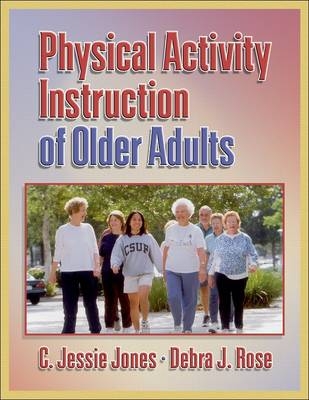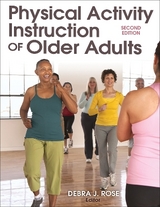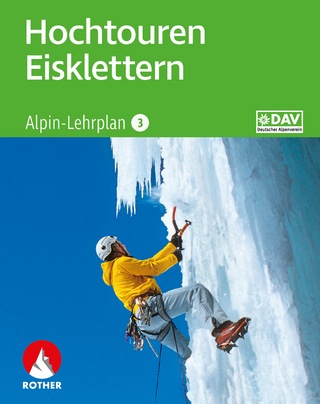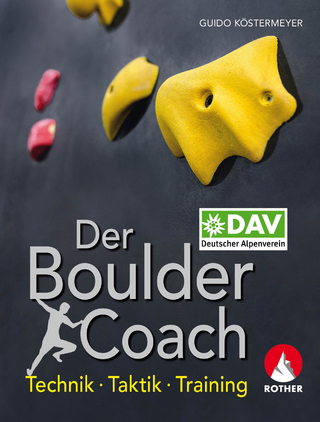
Physical Activity Instruction of Older Adults
Human Kinetics Publishers (Verlag)
978-0-7360-4513-1 (ISBN)
- Titel erscheint in neuer Auflage
- Artikel merken
Physical Activity Instruction of Older Adults is the first book to detail the fundamental knowledge and skills associated with the training modules outlined in the International Curriculum Guidelines for Preparing Physical Activity Instructors of Older Adults. The curriculum guidelines, published in 2004, were developed by an international coalition of senior fitness specialists.
Physical Activity Instruction of Older Adults presents the competency-based objectives that fitness instructors should know and be able to perform to lead safe and effective physical activity programs for older adults with diverse functional capabilities.
A comprehensive blend of theory, practical content, and detailed instruction, the text is organized into five parts:
Part I introduces the new field of gerokinesiology; provides an overview of the aging process; and discusses the benefits of an active lifestyle in disease prevention, health promotion, and quality of life.
Part II provides information and guidelines for preexercise screenings and assessments, client feedback, and goal setting.
Part III focuses on the core fitness and skill components of a well-rounded physical activity program for older adults, including warm-up and cool-down, flexibility and resistance training, aerobic exercise, and balance and mobility training.
Part IV introduces specialty program and training methods, including exercise such as yoga, aquatic exercise, and master athlete training.
Part V covers how to apply principles of motor learning to program design; teaching, leadership, and motivational skills; special considerations for specific medical conditions; and legal and professional ethics and standards for instructors.
Application activities at the end of each chapter help the reader to synthesize the information and prepare them to design well-rounded physical activity programs for older adults. Other student-friendly elements include chapter objectives, introductions, summaries, study questions, key terms, and key points. In addition, numerous photos, figures, and tables make the book not just interesting, but visually appealing as well. This book is ideal for undergraduate students, and it is an excellent reference for physical activity instructors of older adults, fitness specialists, personal trainers, and activity directors.
C. Jessie Jones has an extensive teaching and research background in the area of gerokinesiology. Her specialist areas include assessing the functional fitness of older adults and designing senior fitness programmes. Debra J. Rose is internationally recognised for her work in fall risk reduction assessment. Both authors are professors in the division of kinesiology and health science at California State University and also co-direct the Centre for Successful Ageing.
Part I. Overview of Aging and Physical Activity Chapter 1. The Field of Gerokinesiology Demographics of Older AdultsBenefits of Physical Activity Defining Old Age Gerokinesiology: A New Field of StudyCurriculum Development Summary Key Terms Recommended Readings Study Questions Application Activities Chapter 2. Predictors of Successful Aging Biological Theories of Aging Physical Activity As a Determinant of Successful Aging SummaryKey Terms Recommended Readings Study QuestionsApplication Activities Chapter 3. Psychological and Sociocultural Aspects of Physical Activity for Older Adults Aging Stereotypes Physical Activity, Psychological Well-Being, and Quality of Life Social Implications of Regular Physical Activity Promoting Physical Activity Summary Key TermsRecommended Readings Study Questions Application Activities Chapter 4. Physiological Aspects of Aging Cardiovascular and Respiratory Function Muscle FunctionJoint Mobility Bone Mass Neurological Function Summary Key TermsRecommended Readings Study Questions Application Activities Part II. Screening, Assessment, and Goal SettingChapter 5. Preexercise and Health Screening Preexercise Screening Screening Steps Additional Screening Tools Implications for Program Design and Management SummaryKey Terms Recommended Readings Study Questions Application Activities Chapter 6. Field-Based Physical and Mobility Assessments Functional Fitness Framework Considerations for Test Selection and Evaluation Selected Assessment Tools Guidelines for Group Testing Interpreting Test Results Summary Key TermsRecommended Readings Study Questions Application Activities Chapter 7. Laboratory-Based Physiological Assessment of Older Adults Cardiorespiratory Function Muscular Strength Body Composition Balance Summary Key Terms Recommended Readings Study Questions Application Activities Chapter 8. Goal Setting and Behavioral Management Factors Influencing Older Adults' Exercise Participation Strategies for Behavioral Change Physically Active LifestylesImplications for Program Design and Management Summary Key Terms Recommended Readings Study Questions Application Activities Part III. Core Program Principles and Training MethodsChapter 9. A New Approach to Designing Exercise Programs for Older Adults Heterogeneity of Older Adults Optimizing Physical Function Through Exercise Exercise Variables and Principles for Program Design Specific Exercise Principles for Older Adults Summary Key Terms Recommended Readings Study Questions Application Activities Chapter 10. Principles of the Warm-Up and Cool-Down Physiological Changes Associated with Warm-Up Physiological Changes Associated with Cool-Down Guiding Principles of the Warm-Up Developing the Warm-Up Developing the Cool-Down Summary Key Terms Recommended Readings Study Questions Application Activities Chapter 11. Flexibility Training Age-Associated Changes in Flexibility Types of Stretching Techniques Incorporating Flexibility Training Into the Exercise Program Examples of Flexibility Exercises Summary Key Terms Recommended Readings Study Questions Application Activities Chapter 12. Resistance Training Benefits of Resistance Training Principles of Resistance TrainingTraining Components and Variables Resistance Training for Older Adults Summary Key Terms Recommended Readings Study Questions Application Activities Chapter 13. Aerobic Endurance Training Benefits of Aerobic Endurance Training for Older Adults Principles and Considerations for Aerobic Endurance Training Variables for Aerobic Endurance Training Types of Aerobic Exercises Training Precautions Implications for Program Design and Management Summary Key Terms Recommended Readings Study Questions Application Activities Chapter 14. Balance and Mobility Training Age-Associated Changes in Balance and Mobility Balance and Mobility Exercises Manipulating the Challenge in a Group Setting Summary Key TermsRecommended Readings Study Questions Application Activities Part IV. Specialty Programs and Training MethodsChapter 15. Mind-Body Exercise TrainingMindful ExerciseMind-Body Exercise Programs Implications for Program Design and Management Mindful Exercise PrecautionsYoga and Tai Chi Teacher Training ResourcesSummary Key TermsRecommended Readings Study Questions Application Activities Chapter 16. Aquatic Training Benefits of Aquatic Training Considerations Unique to Aquatic ExerciseAquatic Training ComponentsSummaryKey Terms Recommended ReadingsStudy QuestionsApplication Activities Chapter 17. Training Master Athletes Master Athletes DefinedPrinciples of Training Components of Master Athlete Training Programs Training Precautions Summary Key TermsRecommended Readings Study Questions Application Activities Part V.Program Design, Leadership, and Risk ManagementChapter 18. Applying Motor Learning Principles to Program Design Nervous System Changes and Motor Skill Learning Movement Analysis of Skills Motor Learning Principles for the Physical Activity Instructor Summary Key TermsRecommended Readings Study Questions Application Activities Chapter 19. Teaching and Leadership Skills Teaching Skills Leadership Skills Summary Key TermsRecommended Readings Study Questions Application Activities Chapter 20. Designing and Managing Group Conditioning Classes Key Principles of Group Dynamics Making Group Activity Fun Records Management Marketing Considerations Summary Key TermsRecommended Readings Study Questions Application Activities Chapter 21. Exercise Considerations for Medical Conditions Cardiovascular Conditions Pulmonary Disorders Diabetes Musculoskeletal Conditions Neurological and Cognitive Conditions Summary Key TermsRecommended Readings Study Questions Application Activities Chapter 22. Legal Standards, Risk Management, and Professional Ethics The Law and the Physical Activity Instructor A Risk Management Plan Ethical Guidelines for the Physical Activity Instructor Summary Key TermsRecommended Readings Study Questions Application Activities Appendix A. International Curriculum Guidelines for Preparing Physical Activity Instructors of Older Adults With the Aging and Life Course, World Health OrganizationAppendix B. Professional Ethics for Personal Fitness Trainers Appendix C. Professional Ethics for Group Fitness Instructors Study Question Answer KeyReferences Index About the Editors
| Erscheint lt. Verlag | 1.1.2005 |
|---|---|
| Zusatzinfo | 37 black & white illustrations, 126 black & white halftones |
| Verlagsort | Champaign |
| Sprache | englisch |
| Maße | 216 x 279 mm |
| Themenwelt | Sachbuch/Ratgeber ► Sport |
| Sozialwissenschaften ► Soziologie | |
| ISBN-10 | 0-7360-4513-9 / 0736045139 |
| ISBN-13 | 978-0-7360-4513-1 / 9780736045131 |
| Zustand | Neuware |
| Haben Sie eine Frage zum Produkt? |
aus dem Bereich



